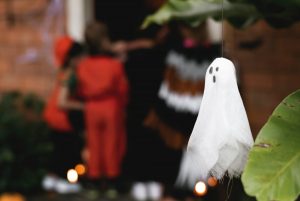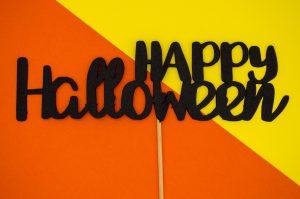By Katalina Stephens
Whether you love it, loathe it, or prefer to lay low through it, Hallowe’en is here in all its grotesque glory! For many of us, this is a really fun time of year when we can get outside of ourselves, be playful with creative costume ideas, and connect with our inner kid (or the actual kids in our lives) by diving into spooky crafts and pumpkin-carving adventures. For a lot of people, though, it can be challenging to reconcile the fun, celebratory side of Hallowe’en with the potentially triggering presence of hyper-sexualized costumes, violent or gory themes, and of course the ubiquitous candy consumption.
 When I was insecure in my own eating disorder recovery, I took solace in connecting with the roots of Hallowe’en and contemplating its spiritual origins. Traditionally called Samhain, a term which loosely refers to the end of the summer season, Hallowe’en comes from ancient Celtic pagan beliefs and traditions. It was the night when the metaphorical veil between the living human world and the unseen realm of the supernatural was at its thinnest – allowing all manner of spirits and unearthly creatures to walk among us. Jack-o-lanterns were carved from turnips, and they lit a path to hallowed crossroads, guiding all the lost souls to a place where they could safely cross over to the next world. People dressed as witches, goblins, ghosts, and demons so that they would blend in and go unnoticed by the legions of beings that might want to play some tricks on an unsuspecting human, and households left out offerings of sweet treats to placate the passing creatures. To me, it’s fascinating to look at the origins of all these Hallowe’en traditions, and see how they have persisted despite centuries of social and political change.
When I was insecure in my own eating disorder recovery, I took solace in connecting with the roots of Hallowe’en and contemplating its spiritual origins. Traditionally called Samhain, a term which loosely refers to the end of the summer season, Hallowe’en comes from ancient Celtic pagan beliefs and traditions. It was the night when the metaphorical veil between the living human world and the unseen realm of the supernatural was at its thinnest – allowing all manner of spirits and unearthly creatures to walk among us. Jack-o-lanterns were carved from turnips, and they lit a path to hallowed crossroads, guiding all the lost souls to a place where they could safely cross over to the next world. People dressed as witches, goblins, ghosts, and demons so that they would blend in and go unnoticed by the legions of beings that might want to play some tricks on an unsuspecting human, and households left out offerings of sweet treats to placate the passing creatures. To me, it’s fascinating to look at the origins of all these Hallowe’en traditions, and see how they have persisted despite centuries of social and political change.
I personally love Hallowe’en – not just because I love all things supernatural and fantastical, but also because it pulls focus toward a more spiritual element of the holiday: remembering and honouring the souls of those we’ve loved and lost, and wishing them safe passage into the unknown beyond our world. When we hit “pause” on all the clichés and trends associated with the season, it’s much easier to breathe through the costumes, crowds, and candy to find something a little deeper and more meaningful.
[dt_quote type=”pullquote” layout=”right” font_size=”big” animation=”none” size=”1″]Once you can identify your own personal Hallowe’en triggers, it will become much easier to come up with healthy self-care practices that will alleviate their effects when you encounter them, like using meditative mantras, plugging into your music, or talking to a friend.[/dt_quote]
Not everyone will feel the same way as I do, of course, and it’s important to plan ahead and be mindful of your own triggers as you approach Hallowe’en 2018. Pay close attention to your self-care needs, and adjust your routine if you need to. It’s also very important that you take some time and space to reflect on the things that trigger you around Hallowe’en. Is it the overtly sexy costumes, candy and treat marketing, gore/violence, crowds, past negative experiences, fireworks, or maybe something else? Once you can identify your own personal Hallowe’en triggers, it will become much easier to come up with healthy self-care practices that will alleviate their effects when you encounter them, like using meditative mantras, plugging into your music, or talking to a friend.
Here are some additional tricks & treats to keep in mind as you walk with the ghosts and goblins this season:
 Remember that this season, just like any other, is not explicitly out to “get” you. Everyone will enjoy Hallowe’en in their own way, and one of the healthiest mindsets we can have is to understand that nobody else’s costume choice, candy consumption, or theme party invitation is intentionally designed to upset you. And for those of us who just plain love to get into the Hallowe’en spirit, we can all try to be mindful of not putting accidental pressure on our friends to get as excited as we are. If you have a friend who just doesn’t dig Hallowe’en, try to meet them on their level and offer some support and understanding.
Remember that this season, just like any other, is not explicitly out to “get” you. Everyone will enjoy Hallowe’en in their own way, and one of the healthiest mindsets we can have is to understand that nobody else’s costume choice, candy consumption, or theme party invitation is intentionally designed to upset you. And for those of us who just plain love to get into the Hallowe’en spirit, we can all try to be mindful of not putting accidental pressure on our friends to get as excited as we are. If you have a friend who just doesn’t dig Hallowe’en, try to meet them on their level and offer some support and understanding.
From all of us at Looking Glass, we wish you a fun, safe, and spook-tacular Hallowe’en!

Katalina is the Volunteer & Program Manager at the Looking Glass Foundation, and holds a degree in Psychology from Simon Fraser University. She loves live music, theatre, writing, and singing when no one is listening.